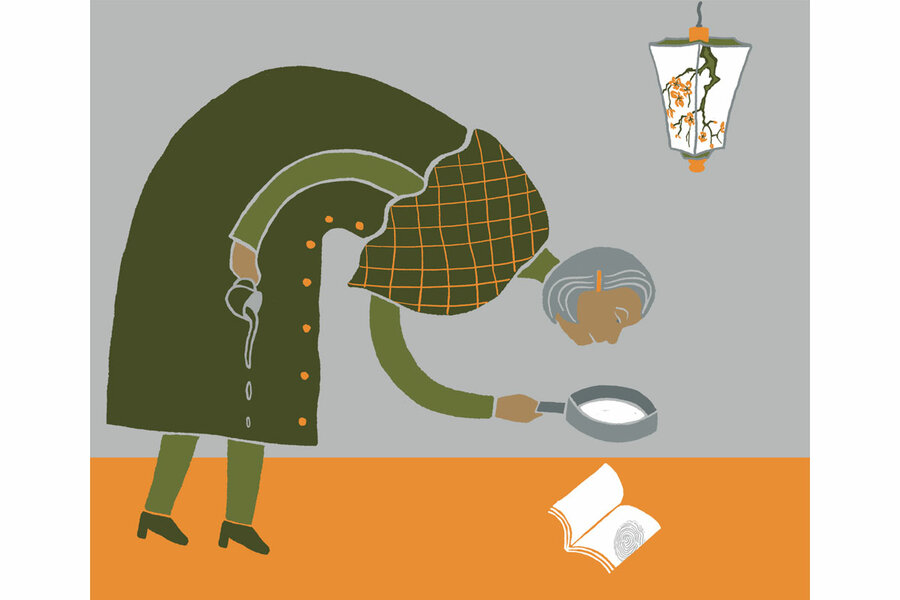Julia Child, Jane Austen, and sleuths of a certain age
Loading...
Somewhere, Miss Marple is wryly smiling, possibly while industriously knitting something fluffy.
The women of a certain age crime-solving trend continues to cast a gimlet eye over a world that really should know better, and readers are all the richer for it. This spring offers several new mysteries to test their wits against.
Why We Wrote This
A story focused onOur picks for spring mysteries include four clever – and transporting – reads starring Austen scions, Julia Child’s chef knife, and a loving, if meddlesome, Chinatown teahouse owner.
A wedding party to celebrate the upcoming nuptials of a local lord ends with said lord crushed beneath a cabinet of his ancestors’ scientific collection in “Death Comes to Marlow,” by Robert Thorogood. More of a “howdunit” than a whodunit, “Death Comes to Marlow” understands the satisfaction that comes from a clever solution.
In “Vera Wong’s Unsolicited Advice for Murderers,” Vera runs a crumbling teahouse in San Francisco’s Chinatown. One morning, she comes down to find a body in the middle of her shop. Vera identifies four suspects, all of whom are the beneficiaries of her top-quality meddling and propensity for whipping up eight-course feasts on a daily basis. “Vera Wong” is a total joy and made me hungrier than anything I’ve read all year.
Somewhere, Miss Marple is wryly smiling, possibly while industriously knitting something fluffy.
The women of a certain age crime-solving trend continues to cast a gimlet eye over a world that really should know better, and readers are all the richer for it.
And while book lovers are waiting for the fourth outing of the consistently outstanding Thursday Murder Club this fall and pining for a sequel to last year’s wickedly funny and feminist “Killers of a Certain Age,” this spring offers several new mysteries to test their wits against.
Why We Wrote This
A story focused onOur picks for spring mysteries include four clever – and transporting – reads starring Austen scions, Julia Child’s chef knife, and a loving, if meddlesome, Chinatown teahouse owner.
The puzzlingly clever “howdunit”
Judith, Suzie, and Becks are back with more crosswords, wild swimming, and murdered gentry in “Death Comes to Marlow,” by Robert Thorogood. A wedding party to celebrate the upcoming nuptials of a local lord ends with said lord crushed beneath a cabinet of his ancestors’ scientific collection. The door is locked, and the key is in his pocket.
His estranged son, meanwhile, was outside talking to our intrepid trio, giving him a perfect alibi. But Judith, who had a phone call from the groom-to-be the day before his death, is convinced it’s murder. Now, to convince the police.
The three women are in fine fettle, with dog-walking grandmother Suzie finding local fame (if not fortune) on the radio and septuagenarian Judith still crafting fiendishly clever crosswords and scandalizing local birdwatchers by skinny-dipping even in winter. Perfect housewife Becks, meanwhile, is acting distinctly squirrelly, to her two friends’ growing concern.
Not to give away her secrets, but never, ever bet against a vicar’s wife in a British mystery. More of a “howdunit” than a whodunit, “Death Comes to Marlow” understands the satisfaction that comes from a clever solution, and author Thorogood constructs his puzzles with care.
A hungry, heartwarming mystery
If “Death Comes to Marlow” appeals to the head, “Vera Wong’s Unsolicited Advice for Murderers” is all heart. Jesse Q. Sutanto – whose “Dial A for Aunties” takes a madcap look at the lengths Singaporean women will go for their loved ones – here creates a stalwart character full of pathos and life lessons she longs to bestow, if only anyone would take the time to listen.
With her husband dead and her lawyer son too busy to answer her texts, Vera maintains her crumbling teahouse in San Francisco’s Chinatown with a clientele that has dwindled to one. One morning, she comes downstairs to find a body in the middle of her shop. To her disgust, the police aren’t sure it’s murder. (Vera may have swiped some incriminating evidence, after carefully outlining the body with a Sharpie. Not only do the police not appreciate her efforts, they refuse to drink her tea.)
Marshall Chen was a loathsome man who everyone had reason to kill. Vera quickly identifies four main suspects: His widow, brother, and an artist and a programmer who are pretending they don’t know the dead man. All four are the beneficiaries of Vera’s top-quality meddling and propensity for whipping up eight-course feasts on a daily basis.
Sutanto writes with pure affection for Vera and her adopted brood of hapless chicks, er, suspects. The only downside is that Vera is right. And someone is guilty. “Vera Wong” is a total joy and made me hungrier than anything I’ve read all year. And given that Julia Child is a character in our next mystery, that is truly saying something.
Murder weapon: Julia Child’s knife
Colleen Cambridge first turned Agatha Christie’s housekeeper into a crimesolver in “Murder at Mallowan Hall” and its sequel. Now, in “Mastering the Art of French Murder,” American expat Tabitha Knight has moved to Paris to care for her aging grandfather and Uncle Rafe as her skills manufacturing airplanes are considered de trop now that World War II has ended. Tabitha keeps her trusty Swiss Army knife in her purse along with her lipstick.
She’s been befriended by a family of Americans in Paris: Julia and Paul Child. While Tabitha can rivet bombers with the best of them, she can’t boil eggs. Meanwhile, Julia is enrolled at the classes at Le Cordon Bleu that will change her life and the course of American cooking.
As the book opens, the biggest mystery is why Julia’s mayonnaise refuses to come together. Then a woman is found stabbed with Julia’s chef knife after a late-night theater party hosted by her sister. The police are eyeing the expats, and Julia asks Tabitha, whose grandfather and uncle have Resistance connections, to clear their names.
The book strays into encyclopedia-speak on occasion, particularly when it comes to post-war Paris, but the mystery’s solution is a clever one. Those who have read Child’s memoir may balk at the idea of Julia playing second fiddle to anyone, but Cambridge has clear affection for both subject and setting. The amount of butter used is totally authentic, and Julia gets the last word.
Austen scions as sleuths
While Jane Austen never got to try her hand at a detective story, she and her characters have had remarkably fruitful fictional careers uncovering evil-doers, from Stephanie Barron’s long-running Jane Austen Mysteries to the incomparable P.D. James’ “Death Comes to Pemberley.”
But Claudia Gray’s 2022 novel, “The Murder of Mr. Wickham,” offers the kind of virtuoso performance that goes well beyond parroting the famous first line of “Pride and Prejudice,” or offering a slightly less well-written variation of Frederick Wentworth’s letter in “Persuasion.” Last year, it was the book I recommended the most to friends stuck in a reading slump.
Part of Gray’s genius was in having two scions of Austen’s romances, Jonathan Darcy and Juliet Tilney, do the sleuthing while their literary parents stayed mostly offstage.
In the sequel, “The Late Mrs. Willoughby,” Jonathan has been invited to Devonshire by some school friends deemed highly suitable by his parents. (One of them is named John Willoughby of Allenham.) And after the recent “unpleasantness” in Surrey, Juliet is on her way to Delaford, to Marianne and Colonel Brandon, where, her parents fervently hope, she will not encounter any more murders. (That kind of thing can give a young girl a reputation.)
Alas, the newly and unhappily married Mrs. Willoughby commits the unpardonable faux pas of drinking port after a party, and drops dead on the spot. With the villagers only too willing to believe Marianne, the woman Mr. Willoughby jilted, to be the murderer, Juliet enlists Jonathan once again to help clear her friend’s name. “There is always someone willing to think the worst. It is work for which volunteers are never lacking,” as Juliet says.
Witty observations abound, as do suspects. The budding romance between our very proper sleuths is not quite a slow burn – more of a sedate simmer. And the solution lies in past hurts. As Jonathan says, “Resentment is, I believe, an even more insidious poison than arsenic.”











